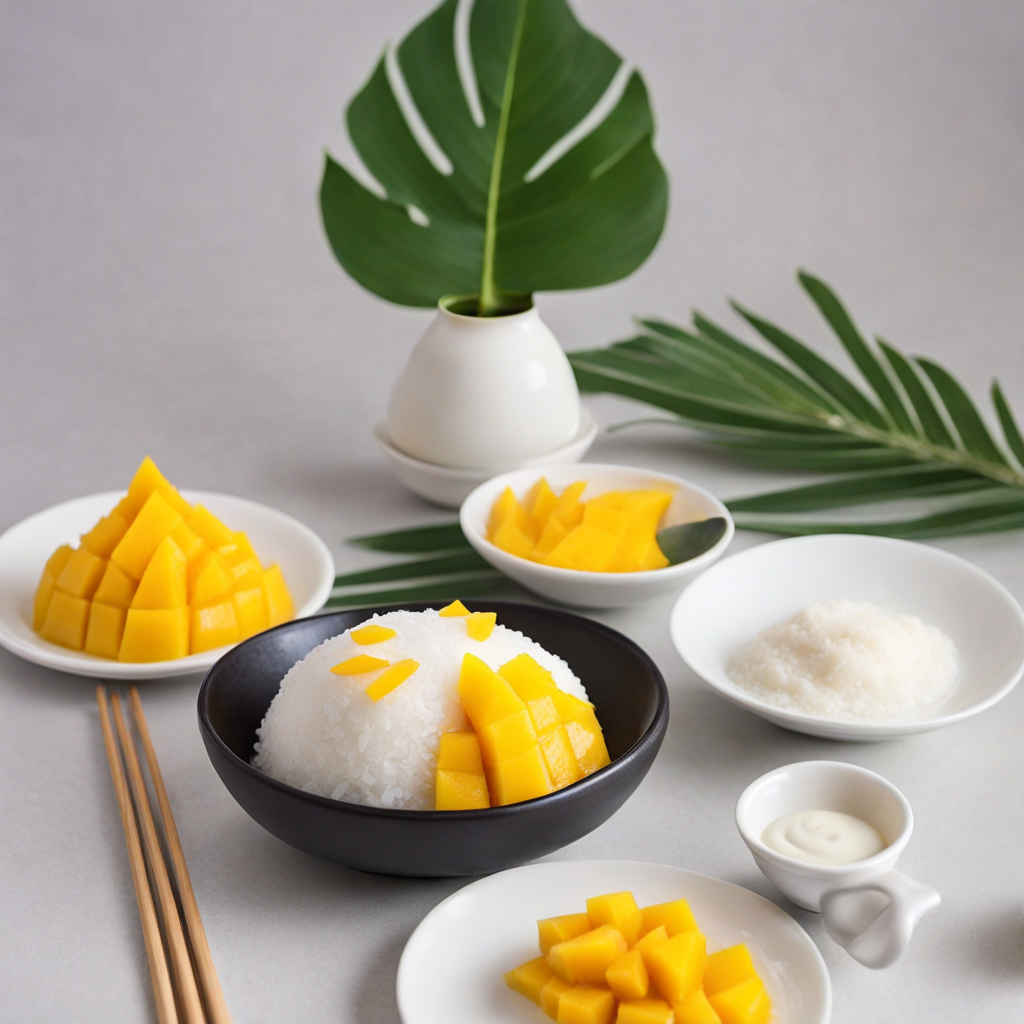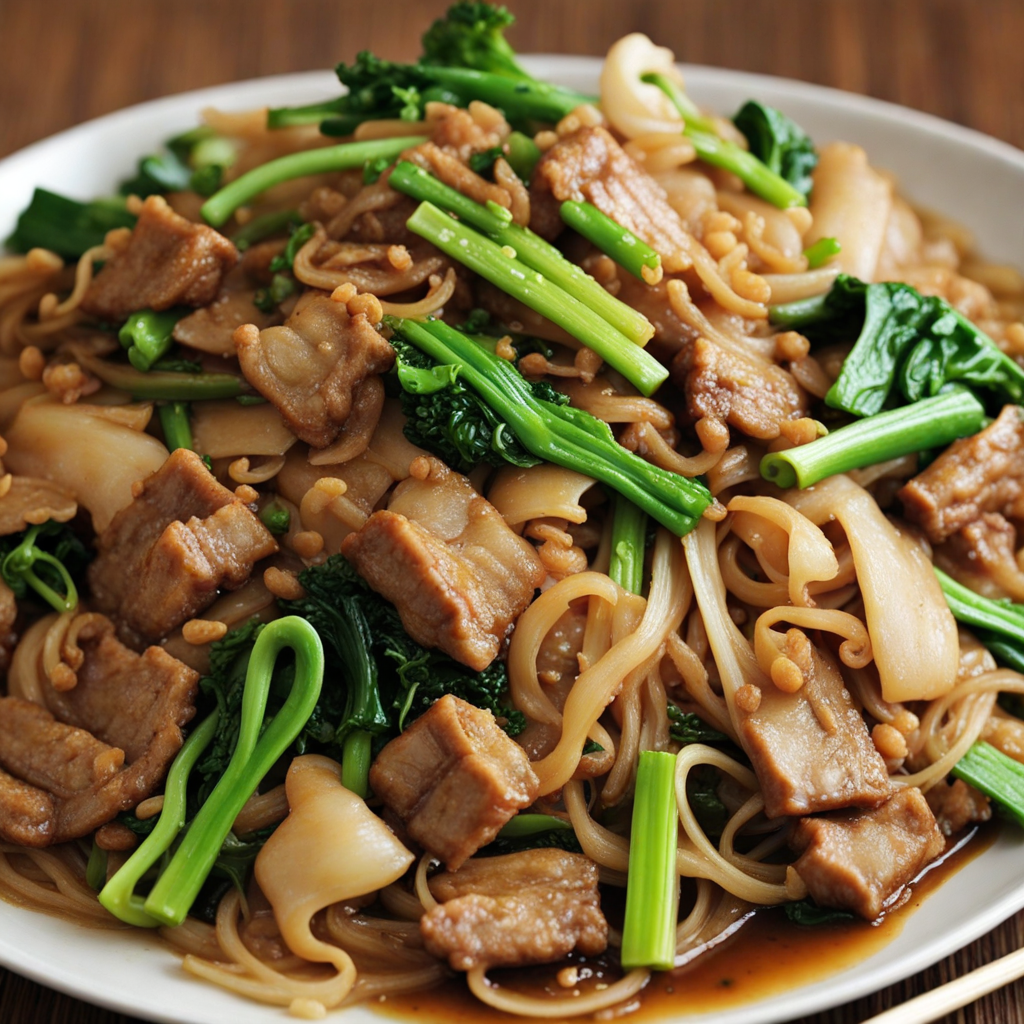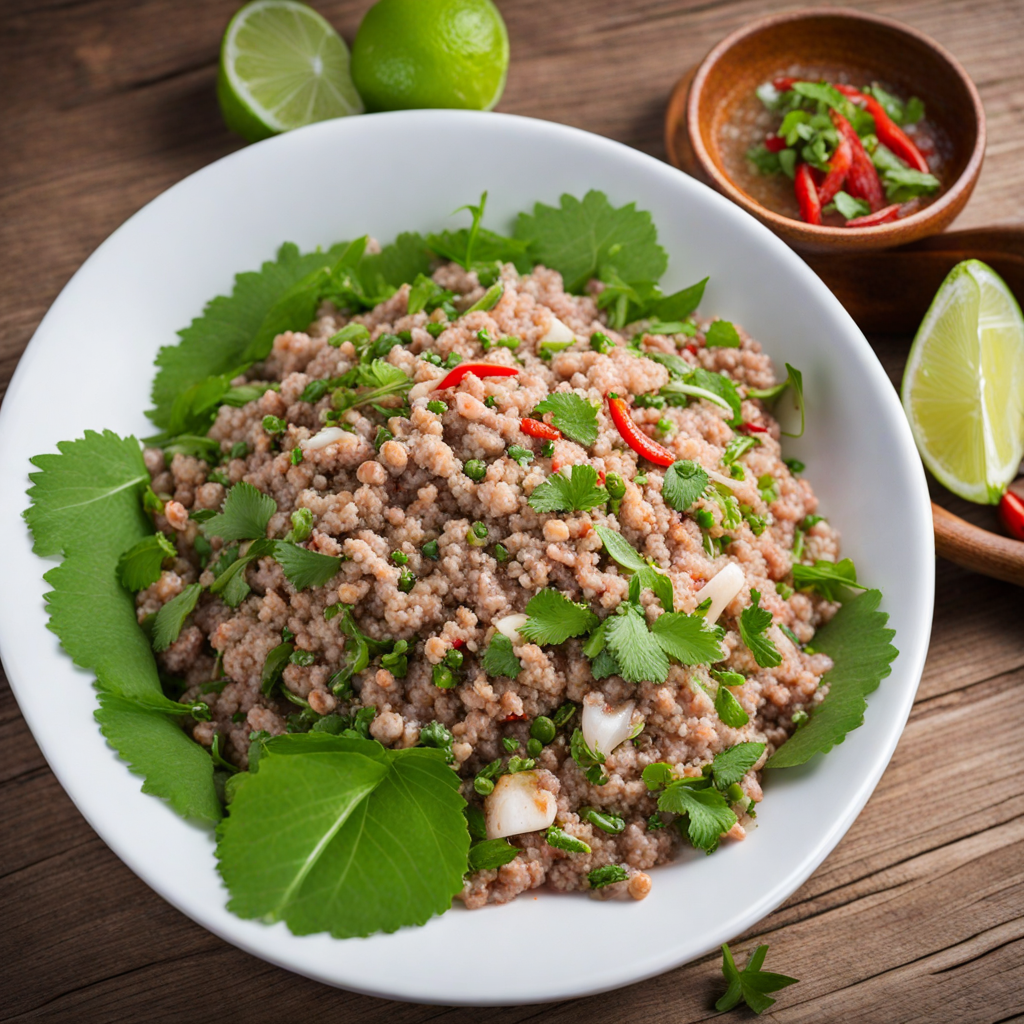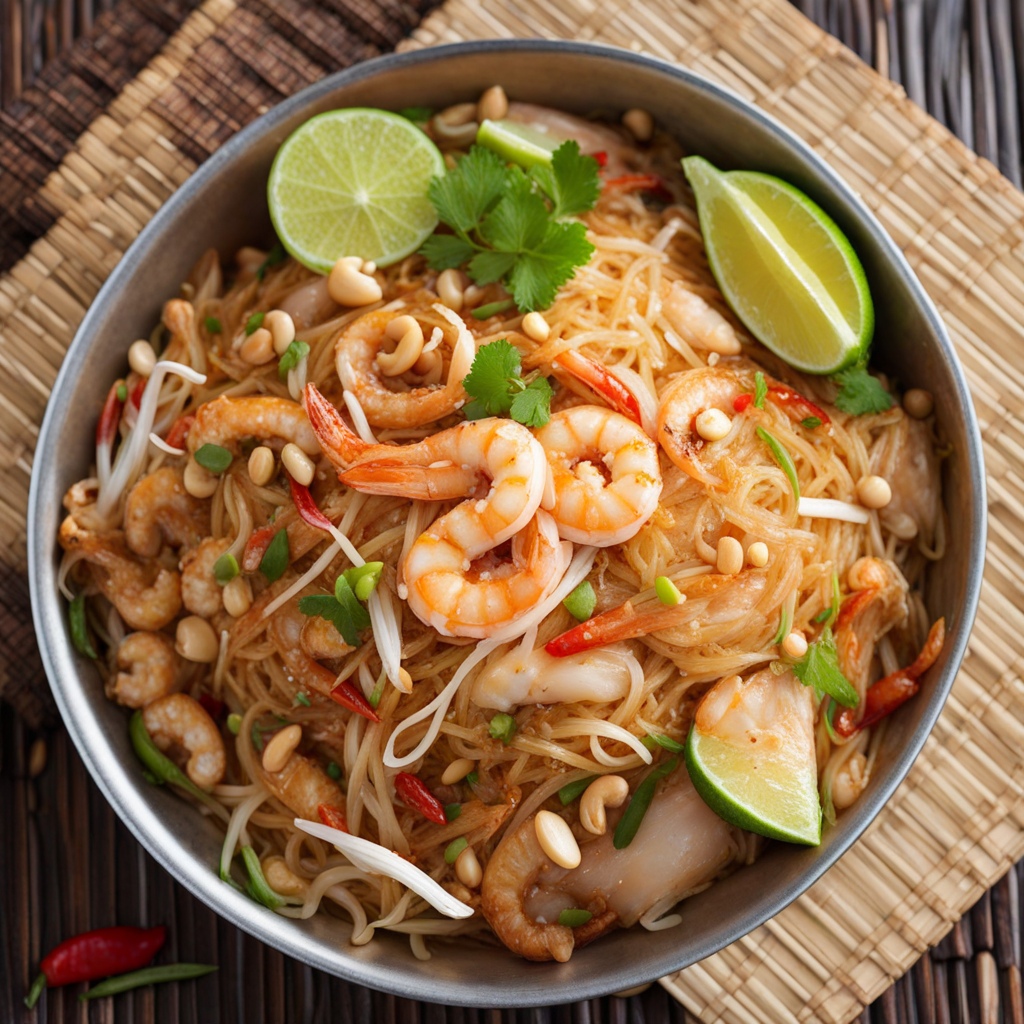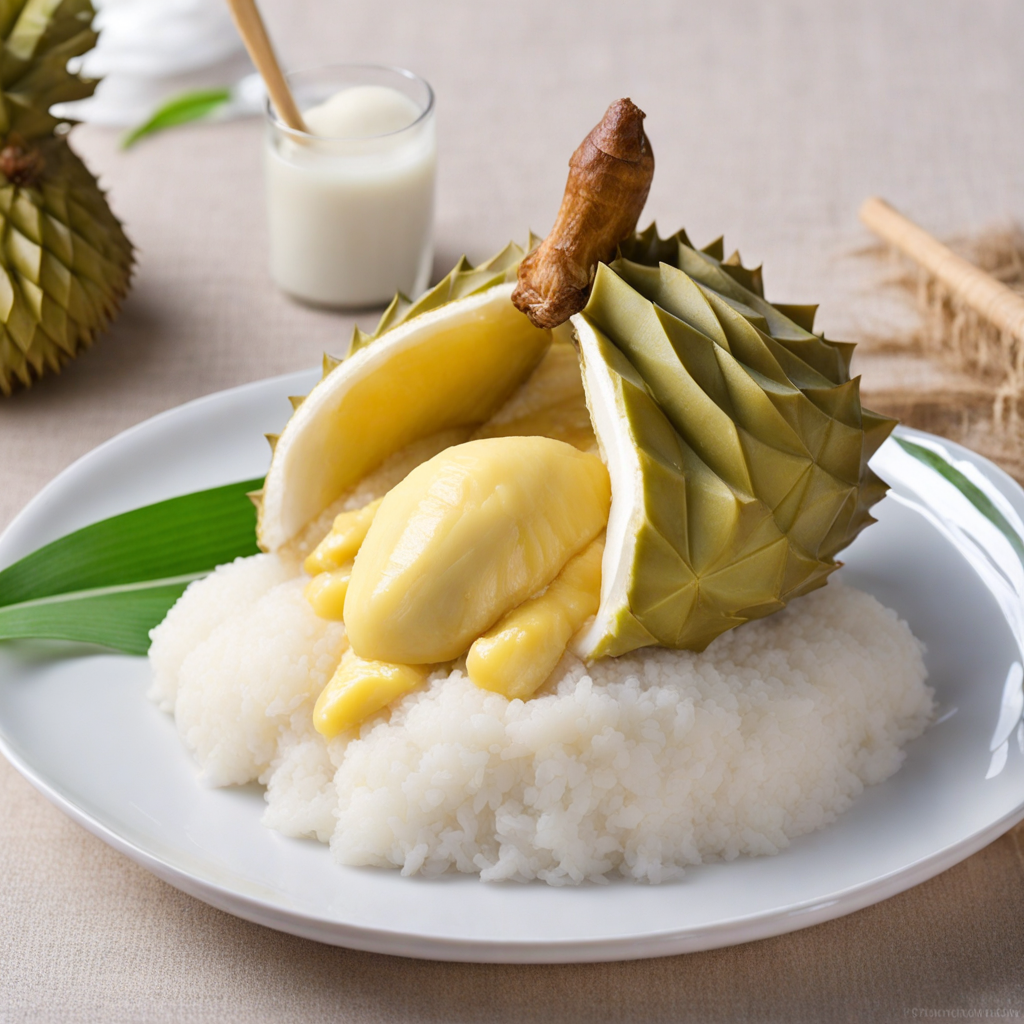Mango Sticky Rice
Mango Sticky Rice is a delightful Thai dessert that beautifully combines the natural sweetness of ripe mangoes with the rich, creamy texture of coconut milk-infused sticky rice. The dish is typically prepared using glutinous rice, which is soaked and then steamed to achieve its unique chewy consistency. Once cooked, the sticky rice is gently mixed with a sweetened coconut sauce, which enhances its flavor and adds a luxurious creaminess. The balance of flavors is further accentuated by a sprinkle of salt in the coconut sauce, providing a subtle contrast that elevates the overall taste experience. The star of the dish, the mango, is often served fresh and sliced, showcasing its vibrant golden hue and juicy flesh. The mangoes used in this dessert are usually of the sweet and fragrant varieties, such as Nam Dok Mai or Keo Savoy, which are known for their rich flavor and smooth texture. When combined with the sticky rice, each bite offers a perfect harmony of sweet and savory notes, making it a truly irresistible treat. Mango Sticky Rice is not just a dessert; it's a sensory experience that highlights the essence of Thai cuisine. Served on a banana leaf for an authentic touch, the dish is often garnished with toasted sesame seeds or mung beans for added texture and visual appeal. The combination of flavors, textures, and colors makes Mango Sticky Rice a beloved favorite among both locals and tourists, inviting anyone who tries it to savor the taste of Thailand in every delightful bite.
How It Became This Dish
The Sweet History of ข้าวเหนียวมะม่วง: A Culinary Gem from Thailand Origins and Ingredients ข้าวเหนียวมะม่วง, pronounced "khao niew mamuang," is a beloved Thai dessert that combines glutinous rice (khao niew) with ripe mango (mamuang) and a sweet coconut sauce. Its origins can be traced back to Thailand's rich agricultural and cultural landscape, where rice, tropical fruits, and coconut are staples. While the exact timeline of this dessert's creation is difficult to pinpoint, glutinous rice has been a significant part of Thai cuisine for centuries, particularly in the central region of Thailand where it thrives. Glutinous rice, also known as sticky rice, is a type of rice grown mainly in Southeast Asia. Unlike regular rice, it has a higher amylopectin content, which gives it a unique sticky texture when cooked. This characteristic makes it perfect for desserts and snacks. The mango, particularly the Nam Dok Mai variety, is favored for its sweetness and fragrance, making it an ideal companion for the rich, creamy coconut sauce that drizzles over the dish. Cultural Significance The preparation and consumption of ข้าวเหนียวมะม่วง are deeply embedded in Thai culture. Traditionally, it is served during the hot season, particularly from March to May, when mangoes are in their peak ripeness. This seasonal association highlights the connection between the dessert and Thai agricultural cycles, as well as the community's reliance on the bounty of nature. In Thai society, food is not merely sustenance; it is an expression of love, community, and identity. The act of preparing and sharing ข้าวเหนียวมะม่วง often occurs during family gatherings, festivals, and special occasions. The dessert is also a common sight at street food stalls and markets, where vendors skillfully assemble the dish, attracting both locals and tourists alike. In Buddhist culture, mangoes hold a special significance as symbols of fertility and prosperity. As such, ข้าวเหนียวมะม่วง is sometimes offered in religious ceremonies and celebrations, reinforcing its status as not just a dessert but a dish imbued with cultural and spiritual meaning. Development Over Time While the fundamental components of ข้าวเหนียวมะม่วง have remained largely unchanged, the ways in which it is prepared and presented have evolved over time. Historical records suggest that sticky rice has been consumed in Thailand for over 4,000 years, with various preparations existing throughout the region. The combination of sticky rice and coconut milk likely emerged as cooks experimented with local ingredients, culminating in the creation of sweet dishes. The dish gained wider popularity in the mid-20th century, coinciding with Thailand's increasing global engagement. As tourism surged in the latter half of the century, culinary traditions began to attract international attention. Food stalls and restaurants began to serve ข้าวเหนียวมะม่วง to foreign visitors, who were drawn to its vibrant colors, delightful textures, and harmonious flavors. As globalization progressed, variations of the traditional dish emerged. While the classic combination of glutinous rice, ripe mango, and coconut sauce remains the most popular, innovative chefs have experimented with new flavors and presentations. Some have introduced different types of mango, such as the green mango, which offers a tart contrast to the sweet coconut sauce. Others have incorporated additional toppings like mung beans, sesame seeds, or even ice cream, appealing to a broader range of tastes. In recent years, the rise of social media has played a pivotal role in the popularity of ข้าวเหนียวมะม่วง. Food bloggers and influencers have showcased the dish on platforms like Instagram and TikTok, leading to a resurgence of interest among younger generations. This exposure has not only heightened its status as a must-try dish in Thailand but has also helped establish it as a representative of Thai cuisine on the global stage. Regional Variations While ข้าวเหนียวมะม่วง is commonly associated with central Thailand, regional variations exist that reflect local tastes and ingredients. For instance, in the northern regions, variations may include the use of different types of rice, such as black or red rice, which add unique flavors and textures. Additionally, the coconut sauce may be flavored with local herbs or spices, showcasing the diversity of Thai culinary traditions. In southern Thailand, where coconut is more abundant, the dish may be served with a thicker coconut cream, resulting in a richer and creamier experience. Vendors in these regions often take pride in their unique recipes and techniques, which have been passed down through generations, adding another layer of cultural significance to the dish. Modern Context and Global Influence Today, ข้าวเหนียวมะม่วง is not only a staple on Thai dessert menus but has also found its way into international cuisine. Thai restaurants around the world highlight this dessert, introducing it to new audiences and adapting it to suit different palates. In Western contexts, for instance, chefs may pair it with contemporary ingredients, such as exotic fruits or chocolate, while still maintaining its original essence. The global appreciation of Thai cuisine has been fueled by the increasing interest in street food culture, with ข้าวเหนียวมะม่วง often touted as a quintessential street dessert. This has led to a greater understanding and admiration for the intricacies of Thai cooking, showcasing the importance of fresh, quality ingredients, and the balance of flavors that characterize Thai food. Conclusion The journey of ข้าวเหนียวมะม่วง from its humble beginnings as a traditional dessert to a global culinary sensation is a testament to the resilience and adaptability of Thai cuisine. This beloved dish encapsulates the essence of Thai culture—its agricultural roots, communal spirit, and the celebration of seasonal ingredients. As it continues to evolve and inspire, ข้าวเหนียวมะม่วง remains a delicious symbol of Thailand's rich culinary heritage, inviting people from all walks of life to savor its sweet, sticky charm. Whether enjoyed at a bustling market or a fine dining establishment, this dessert will undoubtedly continue to hold a cherished place in the hearts of many for generations to come.
You may like
Discover local flavors from Thailand



